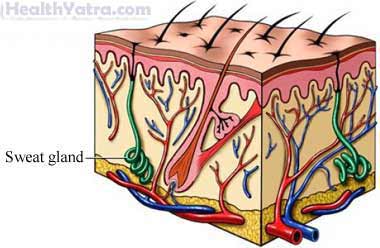تعريف
Hyperhidrosis is excessive sweating. It can be an embarrassing and serious problem. It can affect social, professional, and intimate relationships.
The sweating may be in just one area. It is most common in the palms of the hands, soles of the feet, and/or armpits. In some cases the sweating can also affect the entire body. Hyperhidrosis is divided into two categories:
- Primary hyperhidrosis—has no known cause
- Secondary hyperhidrosis—caused by an underlying condition

أسباب
Primary hyperhidrosis may be triggered by:
- High emotional states (such as intense sadness, fear, anger, or stress)
- Spicy foods
- Hot climates
- أدوية معينة:
- Fever-lowering medicines
- Insulin
- Meperidine
- Emetics (vomit-inducing medicines)
- الكحول
- Pilocarpine
Secondary hyperhidrosis may be caused by conditions such as:
- سن اليأس
- حمى
- العدوى
- Cancer, such as lymphoma
- مرض الغدة الدرقية
- Acromegaly or anterior pituitary tumor
- Hypothalamic disorders
- Adrenal tumor
- Parkinsons disease
- Nervous system disorders
- مرض السكري
- مرض الدرن
- Drug withdrawal
- أدوية معينة:
- Fever-lowering medicines
- Insulin
- Meperidine
- Emetics (vomit-inducing medicines)
- الكحول
- Pilocarpine
عوامل الخطر
Factors that increase your chance of secondary hyperhidrosis are the conditions that cause it (listed above).
الأعراض
تشمل الأعراض ما يلي:
- Sweaty palms of the hands and/or soles of the feet
- Sweaty armpits
- Change in amount of sweating
- Change in pattern of sweating
- Change in the odor associated with sweating
- Stained clothing
التشخيص
Your doctor will ask about your symptoms and medical history. A physical exam will be done. There are no specific tests for this condition.
A starch-iodine test is often used on armpits. It may be used to determine the areas with the most active sweat glands. Tests may be done if your doctor is concerned that you may have a specific medical condition.
العلاج
يشمل العلاج:
تغيير نمط الحياة
To help decrease the uncomfortable feeling and odor associated with sweating, try:
- Frequent clothing changes
- Careful washing
العلاجات الموضعية
A number of treatments can be applied to decrease sweating in a particular area. These include:
- Aluminum chloride hexahydrate
- Aluminum tetrachloride
- Formalin compresses
- Glutaraldehyde compresses
- Iontophoresis (stimulation with electrical current)—needs to be repeated on a daily or weekly basis, eventually tapering off to every 1-2 weeks; may be used if prescription antiperspirants fail
الأدوية
These are very rarely used due to their side effects, but may include:
- Scopolamine
- Phenoxybenzamine
- Propantheline
Botulinum A Neurotoxin
This is the toxin produced by the bacteria that cause botulism. Injections of this toxin can decrease sweating in certain areas. It is often used on the palms of the hands and armpits. The effect of one cycle of injections may last for 6-8 months for most patients.
جراحة
- Endoscopic thoracic sympathectomy—the destruction of nerves that stimulate sweating
- Curettage—local removal of sweat glands via surgical scraping
- الموجات فوق الصوتية
- Liposuction techniques
الوقاية
There are no known ways to prevent hyperhidrosis.
